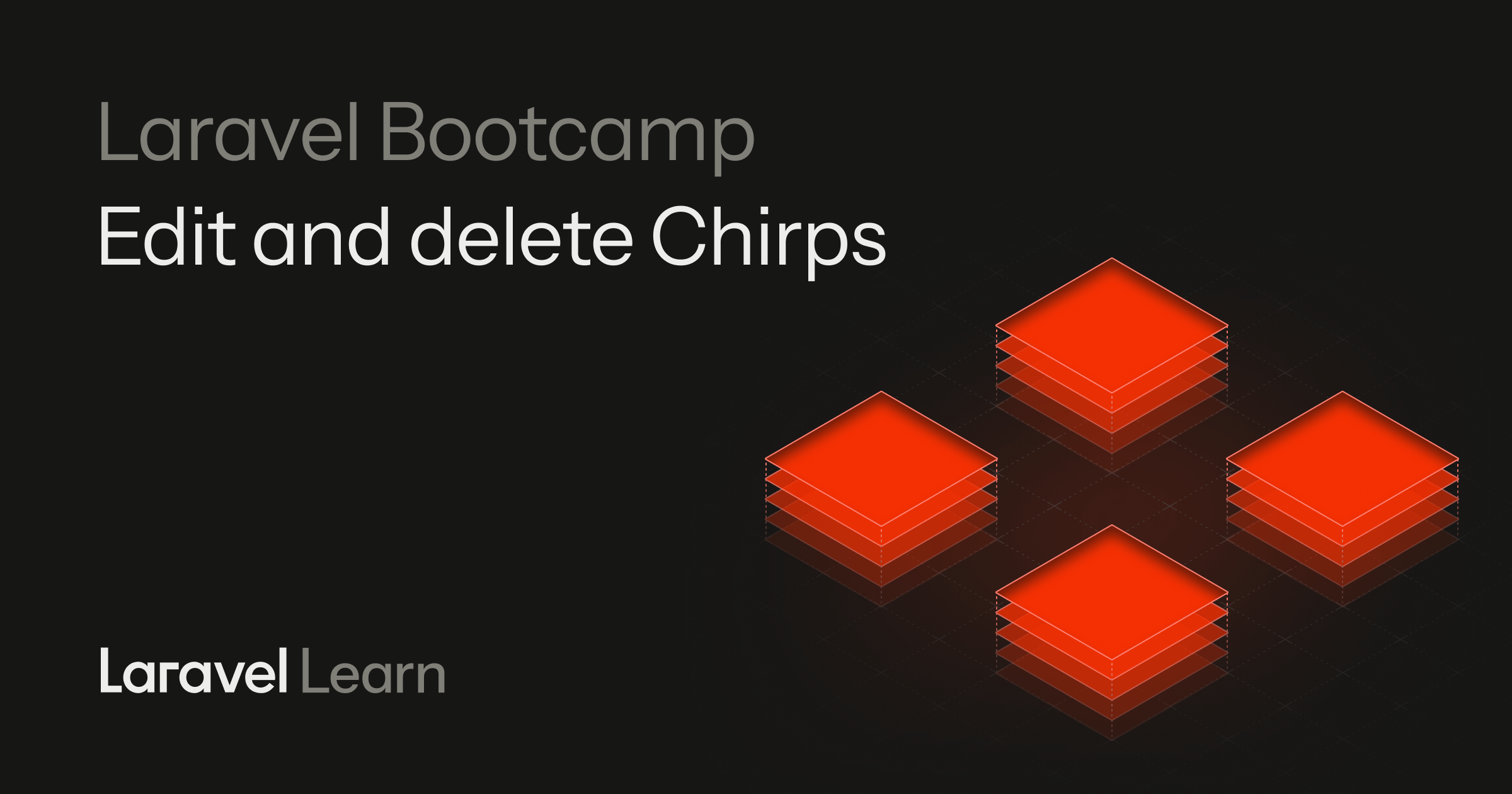00:00
Our chirp application is showing chirps that we have stored in the database,
00:03
but we still don't have a way for our users to actually create their own chirps
00:07
and then store them in the database.
00:09
So that's what we're going to do in today's lesson.
00:12
We're going to build a form, we're going to handle the validation with
00:15
that form, and then we're gonna store those chirps that users create in the
00:19
database, and all of it happens with the things that are built into Laravel.
00:24
Now we're still saving the actual user authentication for a later lesson,
00:28
but we are going to allow our users as anonymous users to create those chirps.
00:33
So why don't we add the form at the top of our feed and we can get going from there.
00:37
We really just want to form right about here after the latest chirps header, and
00:42
then before we actually list the chirp.
00:44
So I'm gonna put a form there, but we're not gonna wire this up.
00:48
Nothing is actually going to happen when we submit this form.
00:51
It's just the plain HTML form.
00:54
There's nothing special about this with one text area and then a button to submit.
01:01
But yeah, there's nothing that actually happens when we hit submit.
01:03
If I was to type anything here and hit submit with this chirp button,
01:08
yes, the message comes up in a URL parameter up here, but we're
01:13
not actually doing anything with that information on Laravel side.
01:18
So why don't we hook this First, I actually want to create the method
01:22
that we're going to be submitting this form to in our controller.
01:26
So why don't we go to our chirp controller?
01:29
And this store method is going to be the perfect method to do
01:32
this because this is creating a resource, in this case, a chirp.
01:36
And this is what is intended for this resource controller.
01:40
We already received the request information, so we're just gonna
01:43
validate that this is validating the request, and then we're storing
01:46
it in this validated parameter.
01:48
We're saying, Hey, this message that we're receiving from this request is required.
01:53
It should be a string and a max of 255 characters.
01:56
So now we have two places where this max is indicated and our validation
02:02
as well as in the database itself.
02:05
Of course, we can also add this to the front end as well.
02:07
I believe we might actually be doing that.
02:10
Yes, max length of 255.
02:12
So this is great to have the front end validation as well
02:15
as the backend validation.
02:16
This is Laravel way of validating anything that comes in through a request.
02:21
We have specific validation parameters that we can add.
02:24
Most of them you'll find in the docs are pretty self-explanatory, and
02:28
believe me, there is a ton of them.
02:30
Next, we're gonna create the chirp.
02:31
So in this case, we can use the chirp model to say, Hey, we're gonna create
02:36
this with a message of the validated message and the user ID of null.
02:42
Of course, we can actually OMI this, but we're gonna add this back in when we get
02:46
to lesson 11 and we add authentication.
02:50
And lastly, we're gonna return a redirect.
02:52
In this case, we're redirecting back to the homepage with
02:57
a specific success message.
02:59
In this case, we're gonna say that there is a success that
03:02
the chirp has been created.
03:05
This is an easy way for our application to know that, hey, this was successful.
03:11
In Laravel, this width function is returning with a
03:15
flash of data to the session
03:16
so in this case, after we redirect back that initial redirect, that initial
03:22
load after this has happened, flashes a piece of data to the session, and
03:27
that data is this success message that has the value of chirp created.
03:33
will see in a little bit how we can grab this information if a chirp
03:37
has actually successfully been created and display that to our user.
03:41
For now, let's hook this up in our web route.
03:43
So similar to our route gi, we're going to have a route post and we'll say this
03:50
is the chirps route and we're gonna pass in the chirp controller, the store method.
03:58
Now in our home, do blade php where we have this form, how do we tell this form
04:03
to submit this information to the slash chirps post route that we just set up?
04:09
Well, it's actually really simple.
04:11
For this form, we're gonna say that there is a method of post because we
04:15
are posting to that slash chirps route, and the action is going to be to that
04:19
specific route, the slash chirps.
04:22
Then there's one more thing that we need to do within Laravel.
04:25
It's this at Csrf directive.
04:29
What that CSRF directive is doing is the equivalent to a hidden
04:32
input field attaching A-C-S-R-F token like you might see here.
04:38
This is something Laravel automatically generates and gives you outta the box.
04:41
It's incredibly easy to use, but it's given to you so you can easily
04:45
protect your site and your application from cross site request forgery.
04:51
And that should be it.
04:52
Why don't we test this out and see if our form works the way we expect it to.
04:55
So one of our latest chirps.
04:57
This is a test of our new form.
05:02
Hi there, boot camp.
05:04
Chirp and look at that.
05:06
Because we are redirected, we automatically receive that new chirp
05:10
because the slash route is automatically getting all of the latest chirps
05:15
and pushing them into our view.
05:17
Now, here's one thing I want to make you aware of that we're not gonna touch
05:21
in this course, but something that you might want to look into in the future.
05:26
It's keeping this form up to date right now.
05:29
You can see here that when we posted it was zero seconds
05:32
ago, I haven't touched it.
05:34
But if anyone else accesses this page, it will see it in a
05:38
different timestamp because it's when they requested that data.
05:42
If I press refresh, okay, now it's one minute ago, so I'm not
05:46
going to see any new chirps until I actually refresh the page.
05:50
Well, Laravel has some great options such as web sockets within
05:54
something like Laravel Reverb.
05:56
In order to say, I want to watch if there are any chirps that are coming
06:00
in, or if there has been a new chirp that comes in, I want to maybe notify
06:06
all users that a new chirp has come in.
06:08
Again, not something that we're gonna be touching on in this course,
06:11
but it's helpful to know that those options are out there and it might be
06:15
a great way to kind of build on top of what we are building here with chirp.
06:19
Alright, we have this form and it works.
06:21
We're submitting anonymous data.
06:23
We don't have to worry about the validation error because if
06:26
I tried to chirp, uh, it says, please fill out this field.
06:29
Well, we have client side validation, but we also have
06:33
server side validation as well.
06:35
Why don't we remove the client side validation so that we see
06:38
what our server sends back.
06:40
I'm going to remove this required parameter, and just for fun, I'm going
06:44
to remove the max length as well.
06:46
Now when we submit our form, we would expect maybe some error, right?
06:50
Because we don't have the client side validation, and we do have the server
06:55
validation in our chirp controller.
06:57
We have validated that this message is required before we
07:01
even continue with the request.
07:04
And if we hit submit.
07:08
Well, we're refreshing the page, but nothing's happening.
07:12
Now the neat part is that Laravel gives if there is any errors within
07:15
the session that has been passed to the view, it has an errors prop.
07:21
In this case, this is a specific variable that we then have access to on our view.
07:28
So just for some quick debugging, we can add this if there are any errors.
07:34
Why don't we dd the all of those errors?
07:37
DD is a little quick helper function that Laravel has that is specifically saying,
07:43
we're going to die and dump in this case.
07:45
Shut down everything that Laravel is doing at that time and just show this.
07:51
Why don't we take a look?
07:52
So if I click chirp,
07:54
We have an array that's our errors array, and it includes a single error.
07:58
The message field is required.
08:01
So how can we make this better for our users?
08:04
Well, let's go ahead and do this.
08:06
Instead of just having this text area, we're going to add a few things.
08:10
We're going to say that if there is an error with a message parameter, that's
08:14
what we're passing from the controller.
08:16
Well then let's go ahead and show that message.
08:19
And this error message is also coming from the text area with the name of message.
08:26
Day UI also gives us the ability to have the text area of an error,
08:30
and so that just displays it easily within the CSS as well.
08:35
We also have this old message, so when we flash a status session, we're redirecting
08:41
to the page then this message text area is going to display the old variables.
08:47
So if we for some reason went over 255 characters, we should then
08:52
redirect and see the old message in the text area with the error.
08:57
for now, just to show this off, we're going to say a max
09:00
of 2 55, but a men of five.
09:04
Now if I try to enter anything under five, let's say hi chirp.
09:10
The message field must be at least five characters.
09:13
That's a error message that Laravel automatically created for us
09:16
based on our validation errors.
09:18
We returned, we had a full redirect.
09:21
We see the high message still in this text area, but now we are
09:25
able to fix this high there chirp.
09:32
I'm pasting way more than 255 characters in.
09:35
We should get that same error.
09:40
Let's go ahead and reset everything.
09:45
And in our home, we're going to add back in that client side validation.
09:57
If I try to add any more characters, you might hear me
10:00
hitting my finger on the keyboard.
10:02
I can't because that max length is affecting this text area field.
10:08
But what about the success as well?
10:11
You might have remembered in our app css, we added this animate, fade out parameter.
10:17
This is so when we do create a component that is a notification component
10:22
for any success messages, this is going to make things a lot easier.
10:26
And actually we're not gonna put this success message in our home Blade pb.
10:33
Instead, we're gonna put this in the layout.
10:35
So I'm going to go to our layout blade php and just under
10:38
the nav, why don't I put this
10:40
in this case, if the session has a parameter of success,
10:44
why don't we show a toast?
10:46
The toast is going to be the toast of top, and this is all mostly Daisy ui,
10:51
but we also do have that animate fade out class that we inputted into our app css.
10:56
This is saying that we're just going to take that session value, the
10:59
success message, regardless of if this is from a posted chirp or if we use
11:06
this in logging in and registering,
11:08
let's post a new chirp.
11:13
And there we have the neat little notification up there at
11:16
the top that nicely fades out.
11:19
Now to add just a little bit of UI nicety before we get into the next lesson,
11:23
if we tried to create a new chirp and we have an error message, of course
11:27
we get the client side validation.
11:29
But if for some reason, uh, we create something that is over 255 characters or
11:34
we bypass client side validation, somehow we're just going to get the generic
11:39
error message that we saw initially.
11:42
What if we want to customize that?
11:44
In this case, if I remove that required client side validation, go
11:47
back into our form and click chirp, we get the message field is required.
11:52
It feels a little, I don't know, not chirp.
11:56
to show off the power of Laravel, we can actually customize
11:59
these validation messages.
12:00
We can say, uh, the message required texts should say, please write
12:05
something, a chirp or the message max text that then gets sent back.
12:10
If this validation does not pass, chirps must be 255 characters or less.
12:17
Why don't we even change up the success message as well?
12:20
Your chirp has been posted, so refreshing.
12:25
Please write something to chirp.
12:26
Now all of a sudden, within a couple of seconds, because of what Laravel gives
12:30
to us, we have the ability to modify something as simple as error messages
12:35
that we don't have to do hardly anything.
12:38
Now in the next lesson, we'll start working on editing and
12:40
deleting chirps even before we get to the user authentication piece.
12:45
But it is helpful to know that while we won't touch on it in
12:48
this particular course, there's so much more that you could add here.
12:51
Even for this particular lesson, what if you don't want your users to post
12:56
five times within a second, or maybe a hundred times within a second?
13:01
There are some bad eggs out there.
13:03
really you can't trust anyone on the web.
13:05
Well, Laravel has the ability to rate limit.
13:08
What that means is that you can, within a matter of minutes, say,
13:12
Hey, this particular chirp method can only be done by a user,
13:18
maybe one time every 60 seconds.
13:22
But before we get into something like that, why don't we check out
13:25
how you can edit and delete chirps?
13:26
See you in the next lesson.







